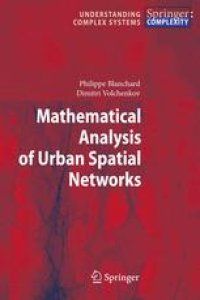
Ebook: Mathematical Analysis of Urban Spatial Networks
- Tags: Complexity, Landscape/Regional and Urban Planning, Cities Countries Regions, Applications of Mathematics, Human Geography
- Series: Understanding Complex Systems
- Year: 2009
- Publisher: Springer Berlin Heidelberg
- Language: English
- pdf
Cities can be considered to be among the largest and most complex artificial networks created by human beings. Due to the numerous and diverse human-driven activities, urban network topology and dynamics can differ quite substantially from that of natural networks and so call for an alternative method of analysis.
The intent of the present monograph is to lay down the theoretical foundations for studying the topology of compact urban patterns, using methods from spectral graph theory and statistical physics. These methods are demonstrated as tools to investigate the structure of a number of real cities with widely differing properties: medieval German cities, the webs of city canals in Amsterdam and Venice, and a modern urban structure such as found in Manhattan.
Last but not least, the book concludes by providing a brief overview of possible applications that will eventually lead to a useful body of knowledge for architects, urban planners and civil engineers.
Cities can be considered to be among the largest and most complex artificial networks created by human beings. Due to the numerous and diverse human-driven activities, urban network topology and dynamics can differ quite substantially from that of natural networks and so call for an alternative method of analysis.
The intent of the present monograph is to lay down the theoretical foundations for studying the topology of compact urban patterns, using methods from spectral graph theory and statistical physics. These methods are demonstrated as tools to investigate the structure of a number of real cities with widely differing properties: medieval German cities, the webs of city canals in Amsterdam and Venice, and a modern urban structure such as found in Manhattan.
Last but not least, the book concludes by providing a brief overview of possible applications that will eventually lead to a useful body of knowledge for architects, urban planners and civil engineers.
Content:
Front Matter....Pages I-XIII
Complex Networks of Urban Environments....Pages 1-54
Wayfinding and Affine Representations of Urban Environments....Pages 55-100
Exploring Community Structure by Diffusion Processes....Pages 101-136
Spectral Analysis of Directed Graphs and Interacting Networks....Pages 137-150
Urban Area Networks and Beyond....Pages 151-157
Back Matter....Pages 159-181
Cities can be considered to be among the largest and most complex artificial networks created by human beings. Due to the numerous and diverse human-driven activities, urban network topology and dynamics can differ quite substantially from that of natural networks and so call for an alternative method of analysis.
The intent of the present monograph is to lay down the theoretical foundations for studying the topology of compact urban patterns, using methods from spectral graph theory and statistical physics. These methods are demonstrated as tools to investigate the structure of a number of real cities with widely differing properties: medieval German cities, the webs of city canals in Amsterdam and Venice, and a modern urban structure such as found in Manhattan.
Last but not least, the book concludes by providing a brief overview of possible applications that will eventually lead to a useful body of knowledge for architects, urban planners and civil engineers.
Content:
Front Matter....Pages I-XIII
Complex Networks of Urban Environments....Pages 1-54
Wayfinding and Affine Representations of Urban Environments....Pages 55-100
Exploring Community Structure by Diffusion Processes....Pages 101-136
Spectral Analysis of Directed Graphs and Interacting Networks....Pages 137-150
Urban Area Networks and Beyond....Pages 151-157
Back Matter....Pages 159-181
....